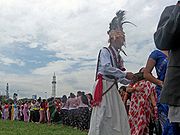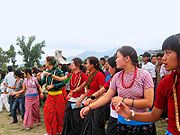
Kirant Mundhum
Encyclopedia

Nepal
Nepal , officially the Federal Democratic Republic of Nepal, is a landlocked sovereign state located in South Asia. It is located in the Himalayas and bordered to the north by the People's Republic of China, and to the south, east, and west by the Republic of India...
. The practice is also known as Kirat Veda, Kirat Veda, Kirat-Ko Veda or Kirat Koved. According to some scholars, such as Tom Woodhatch, it is a blend of animism
Animism
Animism refers to the belief that non-human entities are spiritual beings, or at least embody some kind of life-principle....
(e.g., ancestor worship (Sumnima/Paruhang)), Saivite Hinduism, and Tibetan Buddhism
Tibetan Buddhism
Tibetan Buddhism is the body of Buddhist religious doctrine and institutions characteristic of Tibet and certain regions of the Himalayas, including northern Nepal, Bhutan, and India . It is the state religion of Bhutan...
. It is practiced by about 3.6% of the Nepali population. Before it was recognized as a religion on the Nepali census, 36% of the Kirati population claimed to follow the Kirant religion, but when it was recognized this figure increased to 73.9%, a 157% increase in the Nepali Kiratis.
The Limbu people
Limbu people
The Yakthung or Limbu tribes and clans belong to the Kirati nation or to the Kirat confederation.They are indigenous to the hill and mountainous regions of east Nepal between the Arun and Mechi rivers to as far as Southern Tibet, Bhutan and Sikkim....
have their own distinct religion, known as Yuma Samyo or Yamaism; they believe in the Supreme Almighty goddess Tagera Ningwaphuma.
Mundhum or Kiranti Veda
Mundhum or "Kiranti Veda"' (also known as Peylan) is the religious scripture and folk literature of the KiratKirant
Kirat or Kirati are indigenous ethnic groups of the Himalayas extending eastward from Nepal into India, Burma and beyond. They migrated to their present locations via Assam, Burma, Tibet and Yunnan in ancient times...
people of Nepal
Nepal
Nepal , officially the Federal Democratic Republic of Nepal, is a landlocked sovereign state located in South Asia. It is located in the Himalayas and bordered to the north by the People's Republic of China, and to the south, east, and west by the Republic of India...
, central to Kirat Mundhum. Mundhum means "the power of great strength" in the Kirati language. The Mundhum covers many aspects of the Kirat culture, customs and traditions that existed before Vedic civilisation in South Asia
South Asia
South Asia, also known as Southern Asia, is the southern region of the Asian continent, which comprises the sub-Himalayan countries and, for some authorities , also includes the adjoining countries to the west and the east...
.
The Mundhum for each tribe consists of customs, habits, rituals, traditions, and myths passed down from the Kirati tribe's ancestors. The Mundhum also distinguishes each Kiranti tribe from other Kiranti and non-Kirantis as well.
Practices
Kirats practice shamanismShamanism
Shamanism is an anthropological term referencing a range of beliefs and practices regarding communication with the spiritual world. To quote Eliade: "A first definition of this complex phenomenon, and perhaps the least hazardous, will be: shamanism = technique of ecstasy." Shamanism encompasses the...
and their rituals are mostly related to the worship of mother nature and ancestors. Almost all sacred rituals are performed by nakchong, the kirat priest.
Many followers wear a tilak on the forehead, as in Hinduism
Hinduism
Hinduism is the predominant and indigenous religious tradition of the Indian Subcontinent. Hinduism is known to its followers as , amongst many other expressions...
, when they recite their sacred text, the Kiranti Veda.
Festivals

Sakela
Sakela is the main festival of Kirat which is celebrated twice a year distinguished by two names Ubhauli and Udhauli. Sakela Ubhauli is celebrated during Baisakh Purnima and Sakela Udhauli is celebrated during the full moon day in the month of Mangshir.-Characteristics:The main characteristic of...
is the main festival of Kirat which is celebrated twice a year distinguished by two names Ubhauli and Udhauli. Sakela
Sakela
Sakela is the main festival of Kirat which is celebrated twice a year distinguished by two names Ubhauli and Udhauli. Sakela Ubhauli is celebrated during Baisakh Purnima and Sakela Udhauli is celebrated during the full moon day in the month of Mangshir.-Characteristics:The main characteristic of...
Ubhauli is celebrated during Baisakh Purnima (full moon day, which lies in the month of Baisakh in calenders of the Indian Subcontinent.) and Sakela
Sakela
Sakela is the main festival of Kirat which is celebrated twice a year distinguished by two names Ubhauli and Udhauli. Sakela Ubhauli is celebrated during Baisakh Purnima and Sakela Udhauli is celebrated during the full moon day in the month of Mangshir.-Characteristics:The main characteristic of...
Udhauli is celebrated during the full moon day in the month of Mangshir. Sakela celebration is the prayer to Goddess of Nature for good crops and protection from natural calamities.
The celebration of Sakela is also known as Chandi Nach Murat. On Chandi Nach, they worship Durga, who is known to them as Chandi
Chandi
Chandi or Chandika is the supreme Goddess of Devi Mahatmya also known as Chandi or Durga Sapthashati. Chandi is described as the Supreme reality who is a combination of Mahakali, Maha Lakshmi and Maha Saraswati...
, or Chandika. (Worship of Durga among the Himalayan Kiratas is arguably written in the Harivamsha Purana
Harivamsha Purana
Harivamsha Purana may be*the Vaishnava text Harivamsha*an 8th century Jain text the Harivamshapurana by Jinasena of Punnata lineage....
.) Durga Puja is still performed by a few Kirants.
Tihar is another festival that was added first in the Veda. It is also known as Deepavali and Lakshmi Puja.
Shravan is another festival.
See also
- Folk Hinduism
- Religion in NepalReligion in NepalNepal was the world's last constitutionally declared Hindu state. But after the movement for democracy in early 2006 and the sacking of King Gyanendra, the Nepali Parliament amended the constitution to make Nepal a secular state.- History :...
- Buddhism in NepalBuddhism in NepalBuddha was born in Shakya kingdom which lies in Rupandehi district, Lumbini zone of Nepal.10.74% of Nepal's population practice Buddhism, consisting mainly of groups of Tibeto-Burman origin.-Overview:...
- Hinduism in NepalHinduism in NepalHinduism is the major religion of Nepal. In the 2001 census, approximately 80.6 percent of the Nepalese people identified themselves as Hindus. Buddhists constitute 10.7%. The remainder followed other religions...
- Demographics of NepalDemographics of NepalThe population of Nepal is estimated at 29,391,883 people in July 2011, with a population growth rate of 1.596% and a median age of 21.6 years. Female median age is estimated at 22.5 years, and male median age at 20.7 years...

